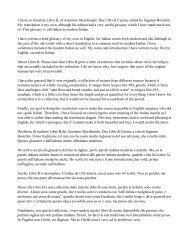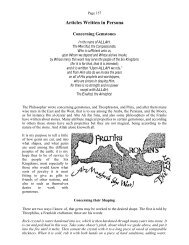How to Milk an Almond Stuff an Egg And Armor a Turnip A ...
How to Milk an Almond Stuff an Egg And Armor a Turnip A ...
How to Milk an Almond Stuff an Egg And Armor a Turnip A ...
Create successful ePaper yourself
Turn your PDF publications into a flip-book with our unique Google optimized e-Paper software.
157<br />
“practice feast” a few weeks before the event: the whole feast done in miniature for 8 people.<br />
(This also helps <strong>to</strong> spot other potential problems with a feast.)<br />
What fed the whole crowd, with a few main dish lef<strong>to</strong>vers <strong>an</strong>d a moderate amount of dessert<br />
lef<strong>to</strong>vers, was: 25 recipes of Badinj<strong>an</strong> Muhassa, 64 recipes of Tabâhajah, 21 recipes of Cooked<br />
Dish of Lentils, 32 recipes of <strong>And</strong>alusi<strong>an</strong> Chicken, 3 recipes of Hais, 8 recipes of Khushk<strong>an</strong><strong>an</strong>aj,<br />
5 recipes of Hulwa, 6.5 recipes of Makshufa, 5 recipes of sek<strong>an</strong>jabin, <strong>an</strong>d about 3 gallons of<br />
lemon syrup.<br />
Work: I deliberately chose low-work dishes, <strong>an</strong>d ones where some of the work could be done<br />
in adv<strong>an</strong>ce. The walnut for the Badinj<strong>an</strong> Muhassa was ground <strong>an</strong>d <strong>to</strong>asted a few days before the<br />
feast, <strong>an</strong>d the Badinj<strong>an</strong> Muhassa was mixed up the day before the feast. The murri for the<br />
Tabâhajah was made the week before. The hardest part of making <strong>And</strong>alusi<strong>an</strong> chicken is turning<br />
onions <strong>an</strong>d green cori<strong>an</strong>der in<strong>to</strong> juice. We did that in adv<strong>an</strong>ce with the help of <strong>an</strong> unmedieval<br />
blender <strong>an</strong>d food processor, turning the kitchen green in the process, <strong>an</strong>d froze the juice. The<br />
onions for the lentil dish were chopped the day before; the desserts were made <strong>an</strong>ywhere from a<br />
week <strong>to</strong> a day in adv<strong>an</strong>ce, depending on how well they would keep. The use of only one platter<br />
per table for the main dishes <strong>an</strong>d rice reduced the amount of washing-up <strong>to</strong> be done.<br />
Kitchens: Our site has two small kitchens, the smaller one with a four-burner s<strong>to</strong>ve <strong>an</strong>d the<br />
larger with a six-burner s<strong>to</strong>ve. Since the food was cooking in very large pots, only two pots could<br />
fit on<strong>to</strong> the smaller s<strong>to</strong>ve <strong>an</strong>d four on<strong>to</strong> the larger. Both the rice <strong>an</strong>d the lentils could start cooking<br />
on the s<strong>to</strong>ve <strong>an</strong>d then be removed <strong>to</strong> finish cooking by their own heat; five gallons of lentils or<br />
nine gallons of rice will stay hot enough <strong>to</strong> cook for a long time. (By the same <strong>to</strong>ken, lef<strong>to</strong>vers<br />
should be put in small containers before being refrigerated after the feast: that much food in one<br />
mass will stay warm enough <strong>to</strong> spoil for a long time even in the refrigera<strong>to</strong>r.) We therefore<br />
cooked the rice <strong>an</strong>d lentils first <strong>an</strong>d the lamb <strong>an</strong>d chicken afterward on the same s<strong>to</strong>ves.<br />
[by Elizabeth; originally published in Tournaments Illuminated #105]<br />
<strong>How</strong> <strong>to</strong> Make Arrack<br />
Sugarc<strong>an</strong>e is also used for the preparation of in<strong>to</strong>xicating liquor, but brown sugar is better for<br />
this purpose. There are various ways of preparing it. They pound Babul bark mixing it at the rate<br />
of ten sers <strong>to</strong> one m<strong>an</strong> of sugarc<strong>an</strong>e, <strong>an</strong>d put three times as much water over it. Then they take<br />
large jars, fill them with the mixture, <strong>an</strong>d put them in<strong>to</strong> the ground, surrounding them with dry<br />
horse dung. From seven <strong>to</strong> ten days are required <strong>to</strong> produce fermentation. It is a sign of<br />
perfection, when it has a sweet, but astringent taste. ... This beverage, when strained, may be<br />
used, but it is mostly employed for the preparation of arrack.<br />
They have several methods of distilling it; first, they put the above liquor in<strong>to</strong> brass vessels, in<br />
the interior of which a cup is put, so as not <strong>to</strong> shake, nor must the liquid flow in<strong>to</strong> it. The vessels<br />
are then covered with inverted lids which are fastened with clay. After pouring cold water on the<br />
lids, they kindle the fire, ch<strong>an</strong>ging the water as often as it gets warm. As soon as the vapour inside<br />
reaches the cold lid, it condenses, <strong>an</strong>d falls as arrack in<strong>to</strong> the cup.<br />
The Ain-i-Akbari, 16th c. Indi<strong>an</strong><br />
Making this is probably illegal in the U.S. The method of distillation is one I first encountered<br />
in a modern survival m<strong>an</strong>ual.





